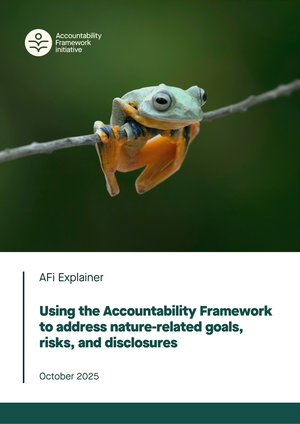
NATURE
Using the Accountability Framework, companies with deforestation and other ecosystem conversion in their supply chains can address their principal nature impacts and risks.
The AFi’s Explainer on nature supports companies to take action on deforestation, conversion, and human rights in line with leading nature instruments.
Understanding nature
The natural world is the basis for our culture, food systems, health, and economy. Robust and diverse natural ecosystems support resilient livelihoods, sustainable food production, and quality of life across the globe.
However, many core elements of nature—land, ocean, water, and atmosphere—are deteriorating, including the vital ecosystem services that underpin economies and societies. Much of this nature loss is linked to the actions of companies whose businesses involve producing, manufacturing, or selling products ranging from oil and gas to food and wood products. To produce agricultural and forestry products, forests and other ecosystems are often converted from their natural state into farms, plantations, and ranches.
Forests are home to an estimated 80% of the world’s land-based animal and plant species, and cover about one-third of global land area. Non-forest natural ecosystems, like grasslands, savannahs, and wetlands, are also highly important for biodiversity and ecosystem services. Globally, deforestation and conversion for agriculture and forestry are responsible for at least 10% of global greenhouse gas (GHG) emissions and one-third of terrestrial biodiversity loss.
As such, eliminating deforestation and conversion from supply chains is a priority nature action for companies with footprints in the land sector.
Guidance for addressing nature-related risks
The concept of nature action has emerged as a way for companies to integrate their actions to protect climate, forests, water, and biodiversity. Amidst efforts by government, corporate, and finance sectors to define and guide responsible action, several NGO-led or multi-stakeholder frameworks have arisen to support companies in understanding, disclosing, and addressing their nature risks.
Implementing deforestation, conversion, and human rights commitments in line with the Accountability Framework puts companies on a path to measurable progress that aligns with the leading nature target-setting and disclosure instruments.
The AFi works closely with many of these nature initiatives to ensure that guidance for company actions and disclosures on deforestation and conversion is consistent and integrated with the Framework. Examples include:
- Science Based Targets Network (SBTN): This initiative has developed nature targets for corporate impacts on land, oceans, and freshwater, which complement the corporate GHG emissions reduction targets put forward by the Science Based Targets initiative (SBTi).
- The Taskforce for Nature-related Financial Disclosures (TNFD): This initiative has standardised companies’ assessment, management, and disclosure of nature-related risks and opportunities across land use change, land management, pollution, water use, and other impacts.
The Accountability Framework also supports and aligns with primary instruments for quantifying and disclosing corporate impact on nature. In this way, it guides companies through assessment and disclosure consistent with SBTN and TNFD, as well as with CDP, GRI, and other reporting platforms.

AFi Explainer on nature
The AFi’s Explainer on using the Accountability Framework to address nature-related goals, risks, and disclosures helps companies understand how action to address deforestation and ecosystem conversion in their supply chain supports broader nature targets and disclosure. The Explainer covers:
- The importance of deforestation and conversion in nature action
- The role of nature frameworks for goal setting and disclosure
- Key concepts related to nature goals, including double materiality and the mitigation hierarchy
- Using the Accountability Framework to set goals, take action, and report progress on nature action
